1. Do you have to be a queen, a princess or a member of the aristocracy to wear a tiara?
In the annals of ancient Greece, hair ornaments akin to garlands graced the noble heads of sacred statues, adorning victors and warriors in triumphant splendor. High-ranking individuals bedecked in gold fillets and foliate wreaths, crafted with delicate laurel leaves, wheat ears, and blossoms, exuded an aura of divine elegance.
Echoing this opulence, the Roman era upheld the tradition, yet with the ebb of their empire and the ascent of Christianity, classical adornments waned into obscurity.
Enter the medieval epoch, where coronals adorned brides of all stations, paving the way for the 18th century renaissance of the tiara. Sparkling gemstones, meticulously cut, replaced simple gold in a testament to lapidaries’ prowess, showcasing dazzling examples of diamond and colored stone magnificence.
.jpg?w=780)
A rare late 18th- / early 19th-century diamond tiara. Old and rose-cut diamonds, closed-set in silver and gold, velvet-covered tiara frame. 5.0 cm high. Sold for £162,500 on 12 June 2019 at Christie’s in London.
The resurgence of ornate head adornments in the 18th century paralleled the rise of a nouveau riche class, eager to display their newfound status through opulent displays of wealth. This trend, coupled with a revived fascination with Classical art, led to a flourishing demand for lavish tiaras.
While many of these exquisite tiaras have been lost to time, the notable exception is the tiara of Queen Charlotte, consort to King George III, which graced Christie’s auction block following her passing in 1818. Described as a “superb tiara” adorned with sprigs of flowers and brilliant-cut diamonds, accented by seven large emerald drops, it epitomized the grandeur of the era.
The zenith of tiara popularity, however, was reached from the 1870s to the eve of World War I, an era characterized by abundant diamond supplies from South Africa and voluminous hairstyles perfectly complementing these majestic accessories.
In the 20th century, the allure of tiaras waxed and waned with shifting economic fortunes and evolving fashion sensibilities. Yet, in recent decades, a resurgence in appreciation for these regal jewels has emerged, fueled by high-profile exhibitions and glamorous celebrity weddings. Today, wearing a tiara is less about social rank and more about discerning its appropriateness for the occasion, embodying a timeless elegance that transcends mere status.
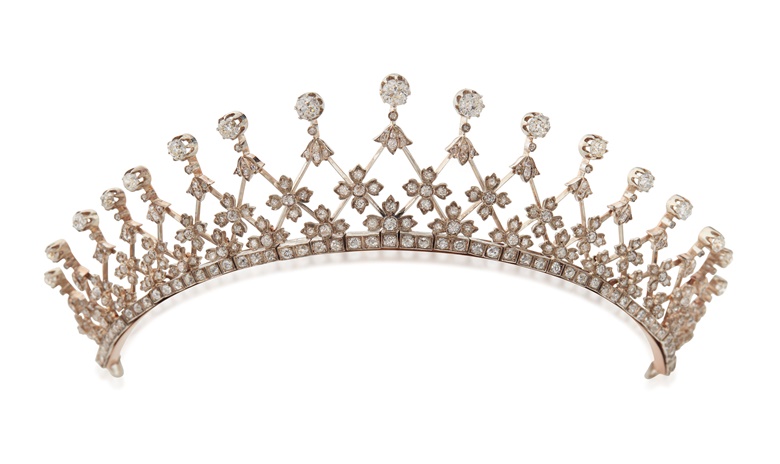
Diamond tiara forming necklace and bracelet, Mellerio. Circular-cut diamonds, silver and 18K gold, 19th century. Price on request. Available for immediate purchase via Private Sales.
2. When should tiaras be worn?
In the past, tiaras were reserved for specific formal occasions like weddings, white-tie affairs, and state events. However, modern times have blurred these boundaries. Traditionally, only married women wore tiaras, often received as wedding gifts. Yet, norms evolve, and nowadays, rules around tiara-wearing are more flexible. Some old-fashioned notions, like restricting tiaras to private residences rather than public places like hotels, seem antiquated in our more relaxed society.
3. What is the difference between a tiara, a circlet, a bandeau and a diadem?
The term “tiara” encompasses various styles of headwear, such as diadems, circlets, and bandeaux. It serves as a broad, inclusive term for a range of decorative headpieces worn for various occasions and purposes.
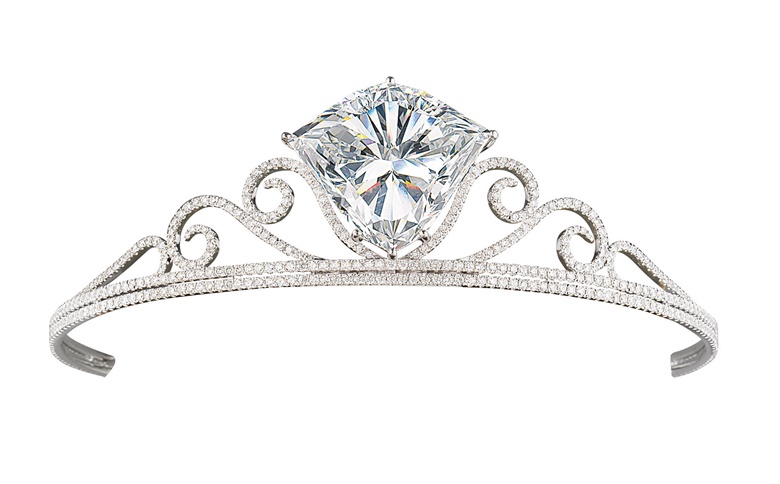
Diamond tiara. Shield-shaped diamond of 101.27 carats, brilliant-cut diamonds, gold. Price on request. Available for immediate purchase via Private Sales.
Diadem: The definition of this term varies depending on historical context. In ancient Greece, “diadem” referred to various head ornaments, derived from the Greek word “diadein,” meaning “to bind around.” Later, it was used to describe a band worn over the head-dress of a king, with the head-dress itself referred to as a tiara.
Circlet: A tiara that encircles or almost encircles the circumference of the head, providing a complete or near-complete loop.
Bandeau: A low-profile headband-style ornament, typically worn on the forehead without a significant height difference from one side to the other. Bandeaux were particularly fashionable during the early 20th century.
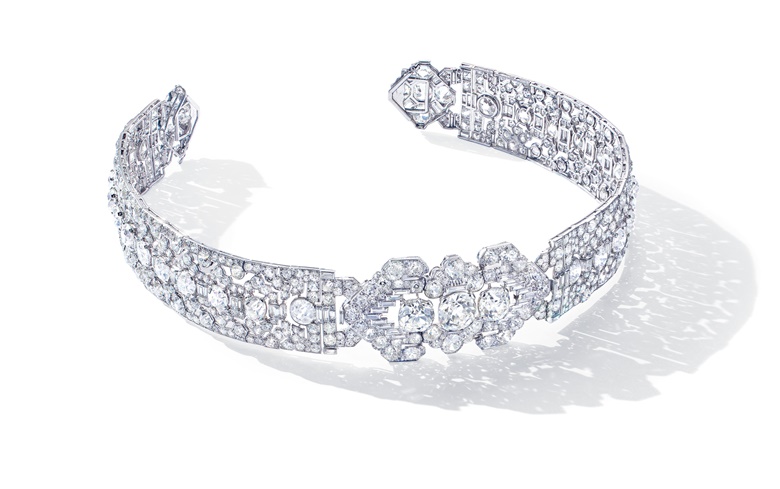
A superb Art Deco diamond bandeau, Cartier, cushion, old and baguette-cut diamonds, platinum (French marks), detachable for wear as a choker, as two bracelets or as a brooch, circa 1920. Bandeau 40.5 cm, choker 34.0 cm, bracelets 17.8 cm, brooch 6.0 c. Sold for CHF 1,065,000 on 12 November 2019 at Christie’s in Geneva.
Kokoshnik: Originating from the rich tapestry of Russian national costume and folklore, the Kokoshnik is a lavish, cloth-covered head ornament known for its expansive width and elevated position on the forehead. During the late 19th and early 20th centuries, renowned jewelers like Fabergé drew inspiration from this tradition, crafting tiaras in the opulent Russian style. Typically, Kokoshnik tiaras feature a fringe of diamond-set bars or a continuous chevron-shaped panel, evoking the grandeur of Russian heritage.
Aigrette: A regal hair ornament placed prominently above the forehead, the Aigrette is designed to support a plume of feathers or depict a gem-set feather motif. Derived from the egret, whose feathers were commonly used in such pieces, the Aigrette exudes an air of elegance and sophistication.
Coronet: A symbol of nobility and rank, the Coronet is a miniature or simplified crown worn primarily by lesser royalty and peeresses. Crafted from gilded silver and often adorned with velvet to denote rank, these coronets feature ball or ‘pearl’ finials that vary in number depending on the wearer’s status. Occasionally worn alongside a tiara, the Coronet adds a touch of regal splendor to any ensemble.
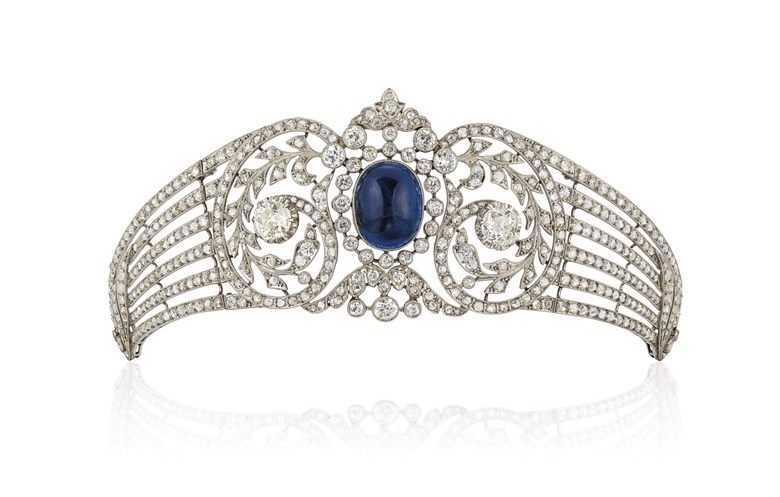
Belle Epoque sapphire and diamond tiara. Cabochon sapphire, rose and old-cut diamonds, circa 1910. 17.0 cm high. Sold for £32,500 on 30 July 2020 at Christie’s in London.
4. Besides diamonds, which gemstones are used for tiaras?
During the late 18th and early 19th centuries, tiaras boasted a diverse array of gemstones, reflecting the eclectic tastes of the era. From the serene allure of coral and pearls to the vibrant hues of amethyst, turquoise, topaz, and citrine, these gemstones adorned tiaras with opulence and charm. Diamonds, synonymous with luxury, occasionally accompanied these gems, adding a touch of sparkle to the ensemble. Notably, materials like cut steel and Berlin iron, while modest in value, held significant prestige, while cameos and intaglios remained enduring favorites, epitomizing the refined elegance of the Napoleonic period.
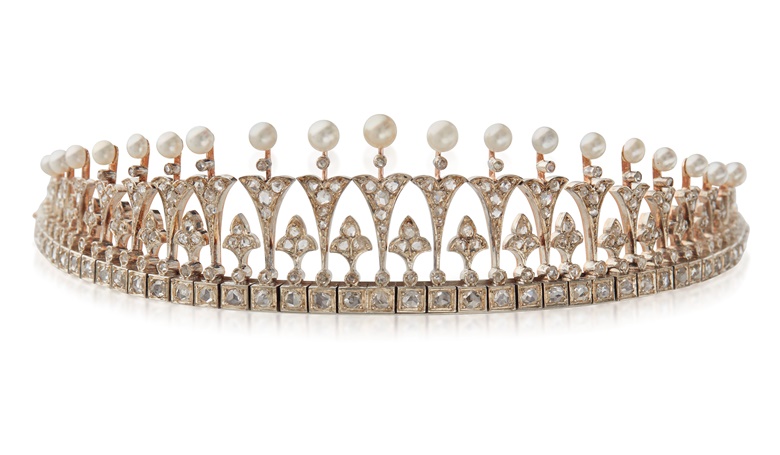
Diamond and pearl tiara forming necklace and bracelet, Daubree. Circular-cut diamonds, white cream button-shaped saltwater natural pearls, silver and 18K gold. Price on request. Available for immediate purchase via Private Sales.
In the latter half of the 19th century, diamonds took center stage but were frequently complemented by vibrant gemstones like sapphires, emeralds, rubies, and pearls. As the 20th century unfolded, design took precedence, ushering in an era where less traditional yet equally captivating stones such as aquamarines, onyx, citrine, and rock crystal became prominent in jewelry design.
5. Who buys tiaras?
Our clientele for tiaras spans a diverse spectrum, but predominantly consists of individuals entering the realm of tiara ownership for the first time, often in preparation for a wedding. Despite the grandeur associated with weddings, acquiring a tiara doesn’t have to be excessively extravagant; prices can range from £5,000 to £10,000, offering an accessible yet significant addition to the wedding ensemble. One of the charms of investing in a tiara is its potential to become a cherished heirloom, passed down through generations and lent out for future family weddings.
Beyond bridal aspirations, we encounter aficionados of fine jewelry seeking to enrich their collections with a regal touch, as well as professionals in the jewelry trade who recognize the allure of offering tiaras for loan to their discerning clientele.
Furthermore, there’s a growing trend among collectors who curate private exhibitions, acquiring tiaras of various styles to showcase in their personal galleries. Museums and galleries also contribute to the demand, occasionally acquiring exceptional pieces to enhance their collections. In remarkable instances, when a signed tiara from illustrious periods like Art Deco, Art Nouveau, or Belle Époque surfaces in the market, the original jewelry house may even repurchase it, either to resell or preserve it as part of its archival treasures.
.jpg?w=780)
19th-century diamond tiara / necklace. Old-cut cushion shaped diamonds, silver and gold. As a tiara 7.3 cm high, as a necklace 41.4 cm, blue velvet case. Sold for £200,000 on 27 November 2019 at Christie’s in London.
6. Are tiaras difficult to wear?
Indeed, the versatility of tiaras extends far beyond the realm of formal events. Many 19th-century tiaras boast a multifunctional design, seamlessly transitioning from a headpiece fit for the grandest affairs to a dazzling necklace suitable for more casual occasions like the opera or a black-tie soirée.
Moreover, some tiaras can be disassembled to create exquisite brooches, hairpins, earrings, or bracelets, offering endless styling possibilities for any social gathering. Whether adorning your lapel with diamond-set brooches or adding a touch of elegance to your hairstyle with sparkling pins, these pieces effortlessly elevate any ensemble, making every moment a special occasion.
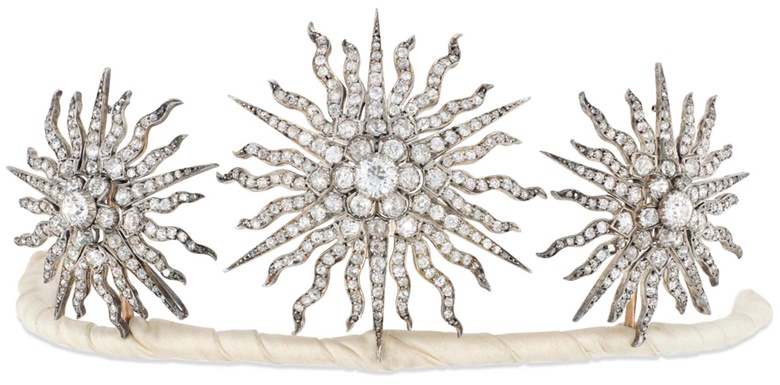
An Edwardian diamond tiara, circa 1900. Largest star 5.7 cm, in fitted case. Sold for £15,000 on 30 November 2016 at Christie’s in London.
It’s a common misconception that tiaras are heavy, outdated, or overly ornate in design. While some antique pieces may indeed be elaborate, crafted during an era when women styled their hair with voluminous pads, modern tiaras offer a refreshing alternative. Take, for instance, the understated elegance of the early 20th-century diamond tiara showcased below. With its sleek and contemporary aesthetic, it seamlessly complements modern attire, proving that tiaras can be both timeless and versatile additions to any ensemble.
7. Tiaras for sale — is it possible to find affordable examples at auction?
Indeed, we’ve presented numerous exquisite tiaras at our London auctions throughout the years, catering to a range of tastes and budgets. Our selection includes smaller antique pieces, with estimates starting from around £3,000, offering an accessible entry point for collectors seeking to add a touch of elegance to their ensemble.
.jpg?w=780)
An early-20th-century diamond tiara, old- and rose-cut diamonds, circa 1910. 20.5 cm. Sold for £23,750 on 12 June 2019 at Christie’s in London.
As one might expect, the price of tiaras tends to rise with the quality and quantity of gemstones incorporated. However, it remains feasible to discover substantial examples priced below £15,000.
8. What other jewels can be worn in the hair?
If you don’t happen to have a tiara on hand but possess a lovely pair of double-clip brooches, fear not—they can serve as elegant hair adornments. Simply pin them on either side of a chic chignon or use them to secure loose strands. Pins can also be a charming addition, especially when clustered in groups of three or four within an up-do.
Should you desire to transform a bracelet or necklace into a tiara, a skilled jeweler can fashion a discreet frame for easy wear in your hair. Imagine the elegance of a diamond rivière necklace gracing your locks!
A word of caution: when using jewels not explicitly crafted for hair, ensure they are securely fastened to avoid any mishaps. Your hairstylist can offer advice on the best techniques for keeping them in place.
Looking to make a statement? Follow in the footsteps of icons like Elizabeth Taylor, who adorned her bouffant hairstyle with brooches, commanding attention with every entrance. Similarly, Princess Diana famously wore an Art Deco bracelet as a chic bandeau across her forehead, showcasing her impeccable style.
.jpg?w=780)
Nitot early 19th century diamonds ‘ears of wheat’ tiara, circa 1811. Vari-shaped old-cut diamonds, silver and gold. 39 cm Estimate: CHF440,000-650,000. Offered in Geneva Magnificent Jewels on 9 November 2021 at Christie’s in Geneva.
9. Iskenderian, what is the most important tiara you have sold
Allow me to present an extraordinary diadem, an exquisite masterpiece crafted entirely from exceptional old-cut diamonds set upon yellow gold, depicting intricate floral motifs and graceful volutes. It is with great delight that we share the accompanying photograph below.

10. Iskenderian, if you could pick a tiara, which one would it be?
An Art Deco or early 20th-century diamond-set tiara would undoubtedly epitomize timeless elegance, with its delicate yet striking design. The versatility of a tiara that seamlessly transforms into a brooch, bracelets or a necklace adds a touch of modern chicness.



